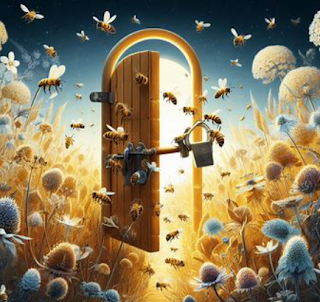Unlocking the Mysteries of Beekeeping: A Journey Through the World of Honey Production
Unlocking the Mysteries of Beekeeping: A Journey Through the World of Honey Production
In the world of beekeeping, spring and summer mark the busiest seasons for those dedicated to nurturing these incredible pollinators. Beekeepers like Jacksonville's own Gary Glaenzer understand that successful beekeeping is a harmonious blend of precise planning, a dash of luck, and a deep trust in the bees' innate abilities.
Discovering the Fascination with Bees
Glaenzer's journey began at the tender age of 12 when he embarked on his beekeeping adventure through 4-H, inspired by a mentor who shared his passion for these remarkable insects. Starting with just one hive, Glaenzer now oversees an impressive 55 hives across Morgan County.
Glaenzer's fascination with bees started with a tree housing these tiny marvels and several hives under his mentor's care. Over the years, he's gained valuable insights into their behavior, discovering that bees typically don't sting if left undisturbed.
The Honey Harvest Season
For Glaenzer, the beekeeping season begins as early as late February or early March when his bees start gathering nectar from plants and flowers. Their hard work continues until October, influenced by weather conditions. This year, with extended warmer temperatures, Glaenzer managed to collect honeycomb as late as early October.
Yet, the remarkable thing about honey production is that it takes a significant number of bees to yield just a few gallons of honey. Each hive starts with 12,000 to 15,000 bees, including foragers and newly hatched bees. At its peak, a hive can host between 60,000 to 70,000 bees, depending on the strength of the Queen Bee. On average, a hive produces around 48 to 60 pounds of honey per year, but this comes with substantial effort.
Inside the Hive
Within a beehive, a Queen Bee plays a pivotal role in laying eggs, regulating hive activity, and swarming. Her unique pheromones distinguish each hive, enabling bees to recognize their own colony. Drones, the male bees, assist in reproduction but don't survive through winter.
The worker bees, which make up the majority of the hive's population (about 80% to 99%), are non-reproducing females. Their responsibilities include collecting pollen and nectar, constructing honeycomb, hive cleaning, and repairs. Worker bees also handle the honey production, sealing cells with wax to preserve the honey.
Transforming Pollen into Honey
The honey-making process is a marvel in itself. Bees gather nectar and pollen from surrounding areas and store them in the honeycomb cells. Using their wings, the bees create airflow to dry the moisture from the nectar, add enzymes, and transform it into honey. Once the majority of the cells are capped, it signifies that the honey is ready for harvesting.
Taking Care of the Hives
While bees tend to most of their needs, there are certain measures beekeepers like Glaenzer take to protect their colonies. They regularly treat hives to prevent mites, which can devastate the bee population. Additionally, protecting hives from small hive beetles is essential to safeguard honey supplies.
From Hive to Market
As the bees produce honey, the beekeeper must strike a balance between taking the comb at the right time and ensuring the bees have enough stores for winter. The extracted comb undergoes a process of wax cap removal, extraction, straining, and bottling. The final honey can vary in color and flavor, depending on the plants the bees gather nectar from.
The Reward of Beekeeping
Despite the challenges and occasional stings, beekeepers like Glaenzer relish the opportunity to contribute to the magical world of honey production. Honey, with its everlasting qualities, serves not only as a delicious treat but potentially as a remedy for allergies.
For anyone considering beekeeping, it's a journey filled with challenges, rewards, and a touch of serendipity. Success, as Glaenzer notes, often hinges on having your hive in the right place at the right time.
#Beekeeping, #HoneyProduction, #BeekeepersLife, #Pollinators, #BeekeepingJourney, #SaveTheBees, #HiveToTable, #BeekeepingTips, #NatureLovers, #Sustainability

대화 참여하기